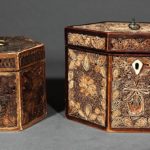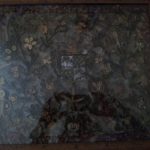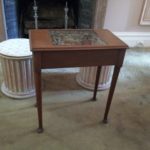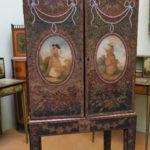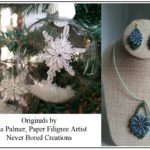The Art of Paper Filigree by Lisa Palmer (Ste. Genevieve)
With its new website and the Show-Me Folk blog, the Missouri Folk Arts Program will publish a number of Stories from the Field. In addition to stories from staff and student workers, we will invite traditional artists, cultural experts, consultants, and community scholars to share photo essays on an array of topics. You may look forward to stories about traditional arts, place stories, and foodways, among others.
Our first guest blogger is Lisa Palmer of Ste. Genevieve. MFAP staff met Lisa when she worked with University of Missouri Extension and coordinated the Mississippi River Hills Association–a cultural and agricultural tourism project in southeast Missouri. First, we worked with Lisa, Tish Johnson, and Leslie Barker on presentations for the 2012 Smithsonian Folklife Festival. A year later, we sought a local liaison to help co-coordinate community scholar workshops in that region, and Lisa was the perfect choice. She worked with us tirelessly to arrange meeting rooms, field trips, and introductions to local tradition bearers. We learned that Lisa herself is a traditional artist: a quilter, a seamstress, and a “paper quiller.” In this photo essay, Lisa Palmer, now self-employed at Never Bored Creations, shows and tells us more about quilling, or paper filigree.
The Art of Paper Filigree
Filigree, also known as paper filigree, rolled paper, and quilling, has origins traced to the French nuns of the 15th century. Paper filigree is fashioned after silver filigree work. With a vow of poverty (and oft times a limited budget!), the nuns used wood and paper in place of silver to create and decorate religious items. As the process of gilding gold leaf onto paper edges of books was available, the nuns would use the process to create even more elaborate papers used in their filigree work.
What is paper filigree? The definition from the North America Quilling Guild: “Is the art of cutting and curling narrow strips of paper and laying them on edge to form intricate filigree designs.”
A description from A General Dictionary of Commerce…by Thomas Mortimer, 1810 provides this historic definition: “a sort of ornamental work, composed of stiff paper and pasteboard of various colours, decorated with gilding, &c, and employed in the embellishment of ladies’ work-baskets, tea-caddies, &c, whereon it is laid in the form of flowers, shells, and the like. The nuns in foreign countries, such as Spain, France, and Italy, make a variety of articles in filigree work, which exhibit peculiar taste and elegance.”
In the 1700 & 1800’s, the ladies of high society would decorate not only tea caddies, they would glue filigree around family paintings; create a framed, filigree version of the family coat of arms; and even decorate furniture. Wooden items were often made with recessed areas to be filled with the paper scrolls and shapes.
[See images below for an exquisite example of tea caddies circa 1790, sold through New Live Auctioneers. You will find other examples of tea caddies and framed pieces on their website: New Live Auctioneers]
Paper filigree examples dating hundreds of years are much more common in Europe in contrast to America. With our history of a transient population, the survival of an item as fragile as paper is rare; the few survivors are highly valued. Most of these items can be found in the Eastern states; however, I had the honor of viewing a piece in New Orleans at the Merieult House. Located on Royal Street, the house is part of the Historic New Orleans Collection of ten historically significant homes. The once open-framed piece was gifted to the family in 1745. [See image below]
Some of the color has faded but much of it still remains vibrant. The shapes and design are wonderful. Notice the coat of arms in the middle with a deer head on the top. I truly enjoy the man in his topcoat in the left corner. Complete with facial features!
In 1950, a special oak table was built for the piece and it was preserved under glass (thus the difficulty of getting a good picture!). The piece is kept in storage and a viewing has to be requested. [Images below]
In my experience, many Americans equate quilling as something their grandmothers did in the Seventies. That would be the 1970s! So, many are very surprised to discover quilling is not a ‘hand craft hobby’ created by their grandmothers but that paper filigree is actually a very intricate and age-old art dating back over 500 years that continues today. Girls were taught filigree in finishing schools. For those of us who enjoy reading, Jane Austin depicts women doing ‘filigree work’ in her novel Sense and Sensibility published in 1811. Modern quilling, the tradition I practice, is also done in 3D work, such as ornaments. I also enjoy creating necklaces and earrings, like the example featured with this story.
No discussion of paper filigree can be complete without a reference to an amazing late 18th century filigree cabinet that is part of the Lady Lever Art Gallery in Port Sunlight Village, Wirral, England. I’ve personally not seen this cabinet – YET! It is on my bucket list along with a trip to the UK Quilling Guild conference held annually in Liverpool. The cabinet picture included with this story is courtesy of my friend, Angela, who wrote the article on the Lady Lever Art Gallery website. There, you can also see an inside and an up-close images: http://blog.liverpoolmuseums.org.uk/2013/09/visit-from-the-quilling-guild/
The art of paper filigree – is it a “lost art”? By no means. Just as the sun shines for a time and fades into the stillness of night only to return, so will paper filigree. Cherish not only the art of gone by, but the work and dedication of this new generation of paper filigree artists.
Lisa Palmer
Paper Filigree Artist
Never Bored Creations.com
Bio: Lisa Palmer is a life-long Missourian living in southeast Missouri. She is a full-time artist active in her local art guild, a juried artist in 2D mixed media and jewelry through the Missouri Artisan Associations/Best of Missouri Hands, as well as an accredited member of the North American Quilling Guild. You may connect with Lisa through by visiting her website: www.NeverBoredCreations.com
@Lisa Palmer, 2017

